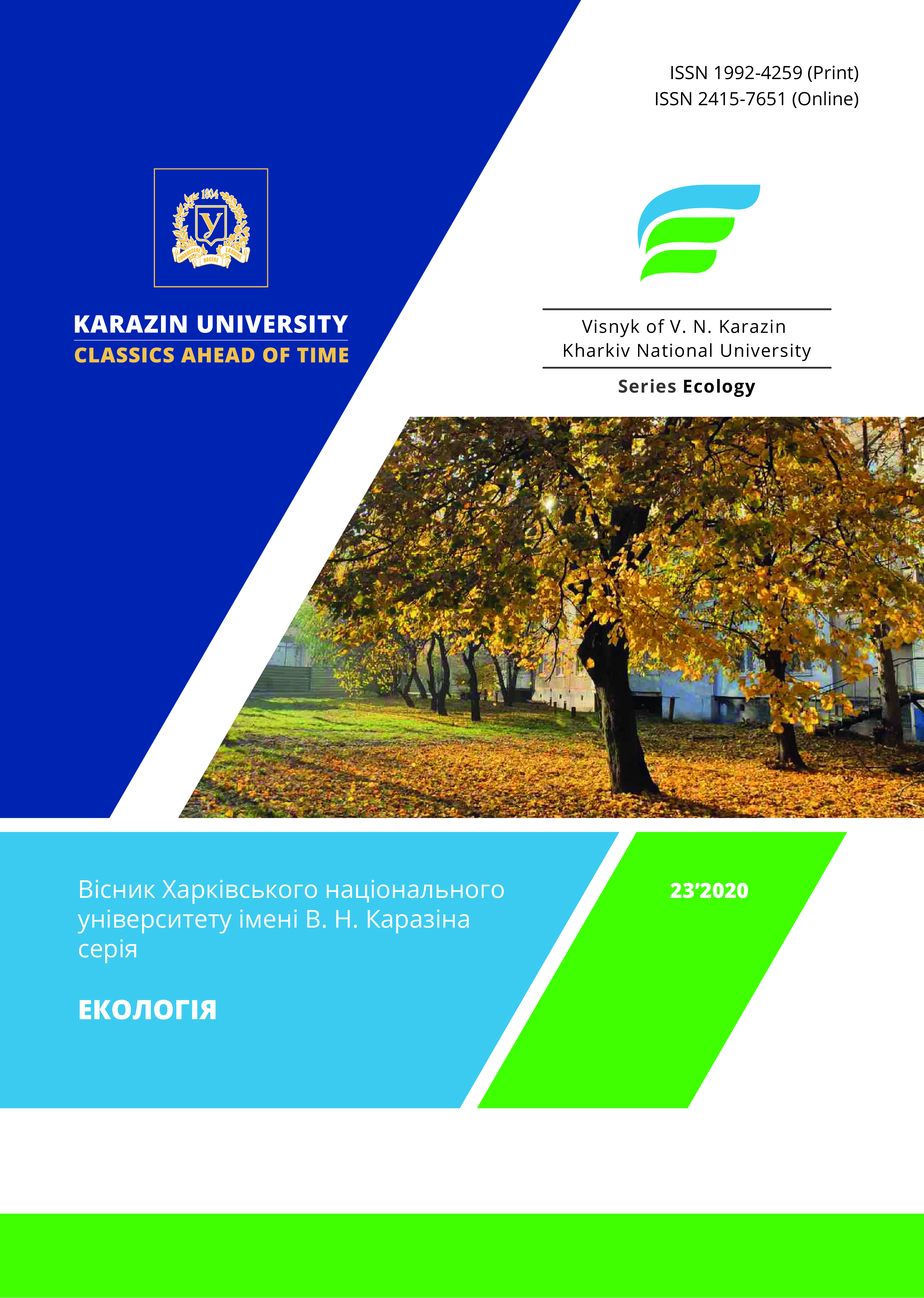Influence of Aerobic Bacteria Concentration on the Process of its Survival in the Presence of Oxygen
Abstract
Purpose of the study is to study the viability of aerobic microorganisms in an oxygen atmosphere with different initial content in the aquatic medium. Compare the effect of gas on different concentrations of bacteria per unit volume of the water.
Methods. Aerobic bacteria of the genus Bacillus cereus bacteria type were the studied microorganisms. Model aqueous media were created on the basis of distilled deaerated water with the addition of bacteria of a particular type. Oxygen was bubbled into the microbial water throughout the process at a rate of 0.2 cm3/s. The duration of the study was 2 hours, during which the total gas consumption corresponded to 1.4 dm3. The number of microorganisms (NM) before and after the experiments was determined by counting the colonies that grew on the Petri dishes.
Results. A two-stage process of oxygen exposure to aerobic bacteria was detected - accumulation and reduction of its number per unit volume of water during all experiments. At the first stage of the process, there
was an increase of NM during 1800-3600 s with its subsequent decrease (II stage). With an increase in the microbial load in the water from 102 to 104 CFU/cm3, the duration of the process of bacterial accumulation was decreased in two times. An active reproduction of bacterial cells was investigated at the low concentration of bacteria in the water, and its active reduction - at the high concentration that is explained by cells destruction under conditions of constant supply of oxygen of the established rate.
Conclusions. The oxygen influence on the change of the number of aerobic microorganisms in the aquatic medium is explained. It is investigated that the oxygen action on bacteria in the water divides the process of its viability into two stages: accumulation (I stage) and reduction of its number (II stage). It is shown that the duration of the process of bacteria accumulation in the oxygen atmosphere depends on its initial amount in the water, namely with increasing of the initial NM per unit volume of the water, the duration of the stage of microorganisms accumulation decreases significantly.
Downloads
References
Kravchenko, M. V. (2015). Physico-chemical analysis of natural drinking water from different sources of water supply. Ecological safety and nature management, 19(3), 52-60. Retrieved from http://es-journal.in.ua/issue/viewIssue/9691/4237 (In Ukrainian)
Ashbolt, N. J. (2015). Microbial contamination of drinking water and human health from community water systems. Curr. Environ. Health Rep., 2(1), 95-106. Retrieved from https://link.springer.com/article/10.1007/s40572-014-0037-5
Kong, Y., Peng, Y. & Zhang Zh. (2019). Removal of Microcystis aeruginosa by ultrasound: Inactivation mechanism and release of algal organic matter. Ultrasonics Sonochem., 56, 447-457. https://doi.org/10.1016/j.ultsonch.2019.04.017
Park, J., Son, Y. & Lee, W. H. (2019). Variation of efficiencies and limits of ultrasonication for practical algal bloom control in fields. Ultrasonics Sonochem., 55, 8-17. https://doi.org/10.1016/j.ultsonch.2019.03.007
Dirisu, G. B., Okonkwo, U. C., Okokpujie, I. P. & Fayomi, S. I. (2019). Comparative analysis of the effectiveness of reverse osmosis and ultraviolet radiation of water treatment. Journal of Ecological Engineering, 20(1), 61-75. https://doi.org/10.12911/22998993/93978
Marois-Fiset, J.-T., Carabin, A., Lavoie, A. & Dorea, C. C.(2013). Effects of temperature and ph on reduction of bacteria in a point-of-use drinking water treatment product for emergency relief. Appl Environ Microbiol., 79(6), 2107-2109. https://doi.org/10.1128/AEM.03696-12
Ivanchenko, L. V., Kozhukhar, V. YA. & Brem, V. V. (2017). Chemistry and water technology. Odessa : Ecology. (In Ukrainian)
Shin, G.-A. & Sobsey, M. D. (2008). Inactivation of norovirus by chlorine disinfection of water. Water Re-search., 42(17), 4562-4568. https://doi.org/10.1016/j.watres.2008.08.001
Mohsen, I. H., Mohsen, A. H. & Zaidan, H. K. (2019). Health effects of chlorinated water: a review article. Pac. J. Biotechnol., 16(3), 163-167. http://doi.org/10.34016/pjbt.2019.16.3.24
Wei, C., Zhang, F., Hu, Y., Feng, C. & Wu, H. (2017). Ozonation in water treatment: The generation, basic properties of ozone and its practical application. Reviews in Chemical Engineering, 33(1), 302-315. http://doi.org/10.1515/revce-2016-0008
Andronov, V., Makarov, Ye., Danchenko, Yu. & Obigenko, T. (2020). Research of the regularities of forming and chemical composition of sewage water of a dairy processing company. Scientific and technical journal «Technogenic and Ecological Safety», 7(1), 13-21. (In Ukrainian)
Myahchenko, O. P. (2010). Fundamentals of ecology. Kyiv: Center for Educational Literature. (In Ukrainian)
Koval, I. Z., Kіslenko,V. N., Starchevskii, V. L. & Shevchuk, L. I. (2012). The effect of carbon dioxide on the viability of bacteria of Bacillus and Diplococcus genera. Journal of Water Chemistry and Technology, 349(2), 112-116. Retrieved from http://jwct.org.ua/docs/t34-n2-187-194_koval.pdf
Dai, Ch., Xiong, F., He, R., Zhang, W. & Ma, Н. (2017). Effects of low-intensity ultrasound on the growth, cell membrane permeability and ethanol tolerance of Saccharomyces cerevisiae. Ultrasonics Sonochem., 36, 191-197. https://doi.org/10.1016/j.ultsonch.2016.11.035
Koval, I. & Starchevskyy, V. (2020). Gas nature effect on the destruction of various microorganisms under cavitation action. Chemistry & Chemical Technology, 14(2), 264-271. https://doi.org/10.23939/chcht14.02.264
Коval, I. (2020). Influence of oxygen and carbon dioxide on water purification from bacteria and yeast under cavitation conditions. Visnyk of V. N. Karazin Kharkiv National University series «Еcоlogy», 22, 75-82. https://doi.org/10.26565/1992-4259-2020-22-07 (In Ukrainian)
Authors who publish with this journal agree to the following terms:
- Authors retain copyright and grant the journal right of first publication of this work under the terms of a license Creative Commons Attribution License 4.0 International (CC BY 4.0).
- Authors are able to enter into separate, additional contractual arrangements for the non-exclusive distribution of the journal's published version of the work (e.g., post it to an institutional repository or publish it in a book), with an acknowledgement of its initial publication in this journal.
- Authors are permitted and encouraged to post their work online (e.g., in institutional repositories or on their website) prior to and during the submission process, as it can lead to productive exchanges, as well as earlier and greater citation of published work.





